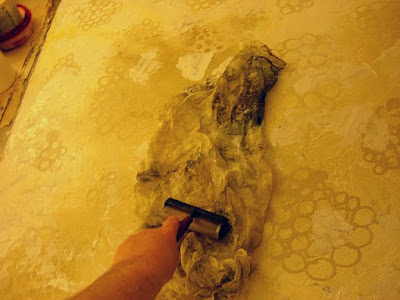I've been posting the progress on three paintings during the last five days that I've been in the studio. The latest thing I did to one of them was to put some molding paste in different areas of the canvas. This is essentially acrylic medium with ground pumice stone in it. When it dries, it looks like plaster, but when it's wet you can press things into the paste and it will retain the imprint of the material. So I took a piece of printmaking scrim and rolled it with a brayer to press it into the molding paste:
I took a close-up picture, in which you can see the imprint of the mesh from the scrim:
It takes a day to dry, after which I can stain it, paint on it, add more texture -- anything, really.
 Subscribe to Praeterita in a reader
Subscribe to Praeterita in a reader
I took a close-up picture, in which you can see the imprint of the mesh from the scrim:

